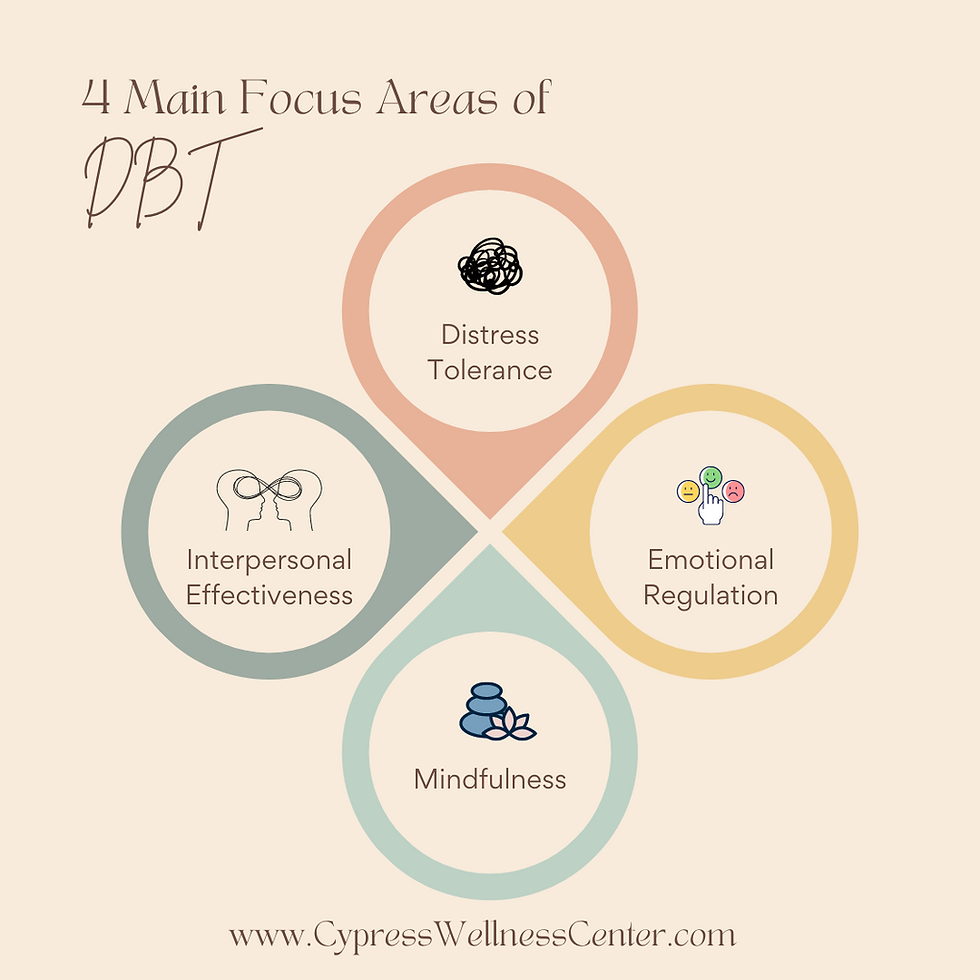What is Dialectical Behavioral Therapy (DBT)?
- Kaci Crook

- Jan 12, 2023
- 4 min read
Updated: Oct 9, 2023
Dialectical Behavioral Therapy, or DBT, is a treatment format that was developed by Marsha Linehan and was originally created to treat clients presenting with borderline personality disorder (a diagnosis that Linehan also received). Over time, DBT has been shown to be effective in treating other presenting concerns – such as addictions, PTSD, suicidality, and eating disorders. DBT involves four main focus areas: Distress Tolerance, Emotional Regulation, Mindfulness, and Interpersonal Effectiveness.

Distress Tolerance refers to our ability to cope with distressing situations – which can be anything that leads to feelings of overwhelm. Distress tolerance skills help us cope with our emotions in a healthy manner, while maintaining an attitude of non-judgmentalism towards our feelings. DBT is known for having numerous worksheets and associated acronyms for its skills, and one of these acronyms is in the distress tolerance section: REST. To take a “REST” involves:
1. Relax – take a second to pause, take a breath, and calm your nerves.
2. Evaluate – ask yourself what the facts are of your current situation. You don’t have to have all the answers right now – and this can be a quick evaluation.
3. Set an intention – think of this as goal setting. This intention can be a small one (i.e., to engage in a self-soothing activity) or a larger one (i.e., to improve communication skills)
4. Take action – develop a plan to meet the intention you set, and begin to put it in place!
DBT contains numerous other skills for distress tolerance, that can be used in a variety of situations.
Emotional Regulation, similarly, are skills that help us cope with our emotions, promote more positive emotions, and facilitate recognition of the full scale of human emotions. There are, once again, numerous skills in this section that can be discussed and practiced. One of these skills is called “opposite action.” When I discuss Opposite Action with clients, I usually combine it with the REST practice as discussed above. First, we have to have a clear understanding of the facts of the situations. It is worth noting, that sometimes our feelings may be out of proportion to the facts of the situation. This does not mean our feelings are wrong or invalid – but rather, that we can take a pause and evaluate our options. If our feelings are leading us down a self-destructive path, then opposite action asks us to do the opposite thing.
Mindfulness is one of my personal favorite topics, and is an important part of DBT. Mindfulness is defined as “the ability to be aware of your thoughts, emotions, physical sensations, and actions – in the present moment – without judging or criticizing yourself or your experience” (McKay et al., 2019). This sounds somewhat easy, but in practice can be harder to accomplish. Think about it: when was the last time that you were driving, “zoned out” and ended up home? Or were listening to a song, and realized halfway through that it’s one of your favorites, so you went back to the start since you weren’t actually listening to the song? Mindfulness activities can include a variety of things: yoga, meditations, grounding exercises (i.e, the 54321 exercise) and many others. One of my favorite practices to introduce (and use myself) is called mindful eating. This practice invites us to be fully present with our meal – to take in the way it looks, smells, and feels before we eat it. If it involves something that needs to be opened (like a candy bar) we may even be able to tune in to our hearing as we eat. Then, even as we begin to eat, this practice invites us to slow down, and really savor the flavors of the food and the experience of eating. In our busy lives, eating is something we are usually already engaging in – so mindful eating is oftentimes an easy skill to incorporate.
Interpersonal Effectiveness skills are designed to increase communication skills, increase empathy, and help decrease impulsivity by increasing supportive interactions. One skill in this section is called “DEAR MAN”: Describe, Express, Assert, Reinforce, Mindfulness, Appear confident, Negotiate. A handout explaining each mini-skill and offering an opportunity to practice can be found here.
As stated earlier – DBT encompasses a wide variety of skills and information that can help promote healing, and only a few are included in this (very brief) overview. ‘Full’ implementation of DBT skills involve individual counseling, on-call coaching, and other modalities combined into an intensive treatment program. In my personal work with clients, I take a DBT-informed approach: using some of the skills offered by DBT and incorporating them with other treatment modalities in order to meet client’s needs.
In addition to work with a trained clinician, there are some useful resources and workbooks that offer DBT skills, such as:
Linehan’s Collection of Handouts and Worksheets (Amazon Link)
This one is much more comprehensive, and developed by the DBT founder!
McKay et al.’s 2019 Self-Help Workbook (Amazon Link)
This one is a bit more easy to read and still pretty comprehensive
The Neurodivergent Friendly Workbook of DBT skills (Amazon Link)
The DBT Workbook for Teens (Amazon Link)
None of the above resources should take the place of healing work done with a trained clinician, but they can offer great starting points and information about DBT skills to implement!
Kaci Crook is a Registered Mental Health Counselor Intern at Cypress Wellness Center. She helps individuals and couples going through a variety of issues. In her work, Kaci incorporates Cognitive-Behavioral Therapy (CBT), Narrative Therapy, and mindfulness. Click "Schedule Now" to schedule an appointment or a 10-minutes phone consultation.





Comments